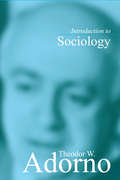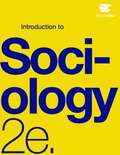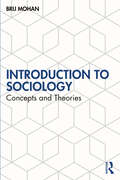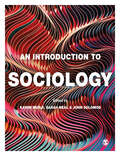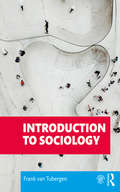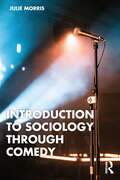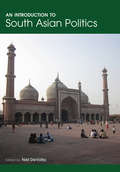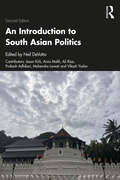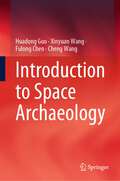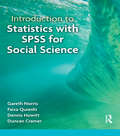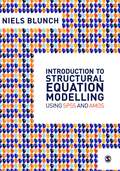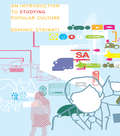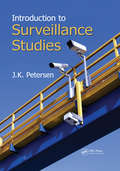- Table View
- List View
Introduction to Sociology
by Theodor W. AdornoThis book provides an invaluable introduction to his historical and conceptual engagement with sociology.
Introduction to Sociology
by Theodor W. AdornoThis book provides an invaluable introduction to his historical and conceptual engagement with sociology.
Introduction To Sociology
by Jeff Bry Faye Jones Heather Griffiths Nathan Keirns Eric Strayer Susan Cody-Rydzewski Gail Scaramuzzo Tommy Sadler Sally VyainIntroduction to Sociology 2e adheres to the scope and sequence of a typical, one-semester introductory sociology course. It offers comprehensive coverage of core concepts, foundational scholars, and emerging theories, which are supported by a wealth of engaging learning materials. The textbook presents detailed section reviews with rich questions, discussions that help students apply their knowledge, and features that draw learners into the discipline in meaningful ways. The second edition retains the book's conceptual organization, aligning to most courses, and has been significantly updated to reflect the latest research and provide examples most relevant to today's students. In order to help instructors transition to the revised version, the 2e changes are described within the preface.
An Introduction to Sociology
by Bryan S. Green Edward A. JohnsAn Introduction to Sociology presents the theoretical approaches, the methods of inquiry, and the concepts with which sociologists attempt to order the intricate phenomena of social interaction. This book provides an illustration of particular investigations that may provide some insights into substantive features of society and social behavior. Organized into six chapters, this book starts with an overview of scientific proposition, which is the statement of a relationship between specified properties of events and objects. This text then explains the fundamental concepts that appear in the empirical and theoretical writings of sociologists. Other chapters present a discussion of what sociologists actually study, which includes the substantive areas of investigation and the aims of the investigation. This book discusses as well the institutionalized areas of society, including the family, the economy, and the polity. The final chapter deals with the theories of the middle-range. This book is a valuable resource for sociologists.
Introduction to Sociology: Concepts and Theories
by Brij MohanThis textbook explores the emergence of sociology as a distinct social science. Focusing on the evolution of social theories, movements and ideas through history, it analyses the dynamic relationship between the individual and the larger social forces around them. This volume examines the definitive aspects of societies, communities and social groups, and their intersections with culture, political and economic movements and religious institutions. It establishes the connections between sociology and other disciplines such as philosophy, history, political science, economics, psychology and anthropology to explore the interdependence between different realms of social life. The chapters in this book explain and highlight the significance of quantitative and qualitative methods of research in understanding the dynamics of social life. Drawing from the works of classical social theorists such as Auguste Comte, Herbert Spencer, Karl Marx, Emile Durkheim and Max Weber, this book traces the development of sociological perspectives and theories and their relevance in the history of ideas. Lucid and comprehensive, this textbook will be useful for undergraduate and postgraduate students of sociology, development studies, history of ideas, sociological thought, social theory, research methods, political science and anthropology.
Introduction to Sociology: Concepts and Theories
by Brij MohanThis textbook explores the emergence of sociology as a distinct social science. Focusing on the evolution of social theories, movements and ideas through history, it analyses the dynamic relationship between the individual and the larger social forces around them. This volume examines the definitive aspects of societies, communities and social groups, and their intersections with culture, political and economic movements and religious institutions. It establishes the connections between sociology and other disciplines such as philosophy, history, political science, economics, psychology and anthropology to explore the interdependence between different realms of social life. The chapters in this book explain and highlight the significance of quantitative and qualitative methods of research in understanding the dynamics of social life. Drawing from the works of classical social theorists such as Auguste Comte, Herbert Spencer, Karl Marx, Emile Durkheim and Max Weber, this book traces the development of sociological perspectives and theories and their relevance in the history of ideas. Lucid and comprehensive, this textbook will be useful for undergraduate and postgraduate students of sociology, development studies, history of ideas, sociological thought, social theory, research methods, political science and anthropology.
An Introduction to Sociology
by Karim Murji John Solomos Sarah NealAn Introduction to Sociology is your essential guide to understanding the social forces that shape our lives and the world around us. This innovative textbook introduces you to the key theories, themes, and concepts in the discipline of sociology and helps you to develop as a sociologist by providing comprehensive coverage of all the main areas of study. Presenting you with the history, current debates and recent research developments for each topic, this book covers everything from classical sociologies and traditional subjects such as class, families, and religion, through to more progressive areas like digital society, social media, migration, and the interconnectedness of modern global society. The book′s extensive coverage means it can be used throughout your studies, from first year to final year. Key features: Each chapter is written by an internationally renowned expert who uses specialist insight and the latest research to provide a reliable and up-to-date overview. Includes a selection of unique learning features such as “Hear from the Expert” boxes and “Key Cases” from around the world, as well as reflective activities and revision questions that will enhance your knowledge. Features a section titled “What is sociology useful for?” which includes chapters on the public value of sociology and the role of sociology in contemporary society. The book is supported by a wide-ranging collection of online teaching and learning resources including exclusive video content from SAGE Video, links to SAGE Journal Articles, sample essay questions, and a selection of multiple-choice questions. This definitive text is perfect for first-year sociology undergraduates and anyone studying sociology at university or college level.
An Introduction to Sociology
by Karim Murji John Solomos Sarah NealAn Introduction to Sociology is your essential guide to understanding the social forces that shape our lives and the world around us. This innovative textbook introduces you to the key theories, themes, and concepts in the discipline of sociology and helps you to develop as a sociologist by providing comprehensive coverage of all the main areas of study. Presenting you with the history, current debates and recent research developments for each topic, this book covers everything from classical sociologies and traditional subjects such as class, families, and religion, through to more progressive areas like digital society, social media, migration, and the interconnectedness of modern global society. The book′s extensive coverage means it can be used throughout your studies, from first year to final year. Key features: Each chapter is written by an internationally renowned expert who uses specialist insight and the latest research to provide a reliable and up-to-date overview. Includes a selection of unique learning features such as “Hear from the Expert” boxes and “Key Cases” from around the world, as well as reflective activities and revision questions that will enhance your knowledge. Features a section titled “What is sociology useful for?” which includes chapters on the public value of sociology and the role of sociology in contemporary society. The book is supported by a wide-ranging collection of online teaching and learning resources including exclusive video content from SAGE Video, links to SAGE Journal Articles, sample essay questions, and a selection of multiple-choice questions. This definitive text is perfect for first-year sociology undergraduates and anyone studying sociology at university or college level.
Introduction to Sociology
by OpenStaxIntroduction to Sociology was written by teams of sociology professors and writers and peer-reviewed by college instructors nationwide. The textbook was developed for OpenStax College as part of its Open Educational Resources initiative. This free online text meets standard scope and sequence requirements and incorporates current events such as the Occupy Wall Street movement. The text is designed for the Introduction to Sociology course at any two- to four-year school.
Introduction to Sociology
by Frank van TubergenComprehensive and engaging, this textbook introduces students not only to foundational sociological work, but also to insights from contemporary sociological theory and research. This combined approach ensures that students become familiar with the core of sociology: key concepts, theories, perspectives, methods, and findings. Students will acquire the ability to think like a sociologist, investigate and understand complex social phenomena. This text presents a complete sociological toolkit, guiding students in the art of asking good sociological questions, devising a sophisticated theory and developing methodologies to observe social phenomena. The chapters of this book build cumulatively to equip students with the tools to quickly understand any new sociological topic or contemporary social problem. The textbook also applies the sociological toolkit to selected key sociological issues, showing how specific sociological topics can be easily investigated and understood using this approach. Taking a global and comparative perspective, the book covers a rich diversity of sociological topics and social problems, such as crime, immigration, race and ethnicity, media, education, family, organizations, gender, poverty, modernization and religion. The book presents a range of helpful pedagogical features throughout, such as: Chapter overview and learning goals summaries at the start of every chapter; Thinking like a sociologist boxes, encouraging students to reflect critically on learning points; Principle boxes, summarizing key sociological principles; Theory schema boxes, presenting sociological theories in a clear, understandable manner; Stylized facts highlighting key empirical findings and patterns; Key concepts and summary sections at the end of every chapter; and Companion website providing additional material for every chapter for both instructors and students, including PowerPoint lecture notes, discussion questions and answers, multiple-choice questions, further reading and a full glossary of terms. This clear and accessible text is essential reading for students taking introductory courses in sociology. It will also be useful for undergraduate and graduate courses in other social science disciplines, such as psychology, economics, human geography, demography, communication studies, education sciences, political science and criminology.
Introduction to Sociology
by Frank van TubergenComprehensive and engaging, this textbook introduces students not only to foundational sociological work, but also to insights from contemporary sociological theory and research. This combined approach ensures that students become familiar with the core of sociology: key concepts, theories, perspectives, methods, and findings. Students will acquire the ability to think like a sociologist, investigate and understand complex social phenomena. This text presents a complete sociological toolkit, guiding students in the art of asking good sociological questions, devising a sophisticated theory and developing methodologies to observe social phenomena. The chapters of this book build cumulatively to equip students with the tools to quickly understand any new sociological topic or contemporary social problem. The textbook also applies the sociological toolkit to selected key sociological issues, showing how specific sociological topics can be easily investigated and understood using this approach. Taking a global and comparative perspective, the book covers a rich diversity of sociological topics and social problems, such as crime, immigration, race and ethnicity, media, education, family, organizations, gender, poverty, modernization and religion. The book presents a range of helpful pedagogical features throughout, such as: Chapter overview and learning goals summaries at the start of every chapter; Thinking like a sociologist boxes, encouraging students to reflect critically on learning points; Principle boxes, summarizing key sociological principles; Theory schema boxes, presenting sociological theories in a clear, understandable manner; Stylized facts highlighting key empirical findings and patterns; Key concepts and summary sections at the end of every chapter; and Companion website providing additional material for every chapter for both instructors and students, including PowerPoint lecture notes, discussion questions and answers, multiple-choice questions, further reading and a full glossary of terms. This clear and accessible text is essential reading for students taking introductory courses in sociology. It will also be useful for undergraduate and graduate courses in other social science disciplines, such as psychology, economics, human geography, demography, communication studies, education sciences, political science and criminology.
An Introduction to Sociology
An Introduction to Sociology is your essential guide to understanding the social forces that shape our lives and the world around us. This innovative textbook introduces you to the key theories, themes, and concepts in the discipline of sociology and helps you to develop as a sociologist by providing comprehensive coverage of all the main areas of study. Presenting you with the history, current debates and recent research developments for each topic, this book covers everything from classical sociologies and traditional subjects such as class, families, and religion, through to more progressive areas like digital society, social media, migration, and the interconnectedness of modern global society. The book′s extensive coverage means it can be used throughout your studies, from first year to final year. Key features: Each chapter is written by an internationally renowned expert who uses specialist insight and the latest research to provide a reliable and up-to-date overview. Includes a selection of unique learning features such as “Hear from the Expert” boxes and “Key Cases” from around the world, as well as reflective activities and revision questions that will enhance your knowledge. Features a section titled “What is sociology useful for?” which includes chapters on the public value of sociology and the role of sociology in contemporary society. The book is supported by a wide-ranging collection of online teaching and learning resources including exclusive video content from SAGE Video, links to SAGE Journal Articles, sample essay questions, and a selection of multiple-choice questions. This definitive text is perfect for first-year sociology undergraduates and anyone studying sociology at university or college level.
Introduction to Sociology Through Comedy
by Julie MorrisQuestioning society and one’s place in it is a common theme in both comedy and sociology. Understanding and subverting hierarchies and norms, exploring deviance and taboos, and relating lived experience to broader questions all hold a crucial place for them both.Introduction to Sociology Through Comedy teaches foundational sociological concepts using comedy, first considering the history of sociology before employing examples from comedians – including standalone comedy bits, sketches, characters, and scenes – to illustrate a specific theory, concept, or social phenomenon. The profession of comedy is then used as a case study for the application of sociological concepts, such as impression management, social stratification, racial segregation, deviance, and stigma, allowing readers to gain familiarity with the concepts while simultaneously practicing their application.This book explains why we laugh by applying theories of humor, which will bolster students’ understanding of sociological principles by forcing them to question their own assumptions – helping them to put why they laugh into sociological terms.
Introduction to Sociology Through Comedy
by Julie MorrisQuestioning society and one’s place in it is a common theme in both comedy and sociology. Understanding and subverting hierarchies and norms, exploring deviance and taboos, and relating lived experience to broader questions all hold a crucial place for them both.Introduction to Sociology Through Comedy teaches foundational sociological concepts using comedy, first considering the history of sociology before employing examples from comedians – including standalone comedy bits, sketches, characters, and scenes – to illustrate a specific theory, concept, or social phenomenon. The profession of comedy is then used as a case study for the application of sociological concepts, such as impression management, social stratification, racial segregation, deviance, and stigma, allowing readers to gain familiarity with the concepts while simultaneously practicing their application.This book explains why we laugh by applying theories of humor, which will bolster students’ understanding of sociological principles by forcing them to question their own assumptions – helping them to put why they laugh into sociological terms.
An Introduction to South Asian Politics
by Neil DeVottaThis introductory textbook provides students with a fundamental understanding of the social, political, and economic institutions of six South Asian countries: Afghanistan, Bangladesh, India, Nepal, Pakistan, and Sri Lanka. It adopts a broad theoretical framework and evaluates the opportunities and constraints facing South Asia’s states within the context of democracy. Key features include: An introduction to the region. The history and political development of these South Asian states, including evaluations of their democratic trajectories. The management of conflict, economic development, and extremist threats. A comparative analysis of the states. Projections concerning democracy taking into consideration the opportunities and constraints facing these countries. This textbook will be an indispensable teaching tool for courses on South Asia. It includes pedagogical features such as political chronologies, political party descriptions, text boxes, a glossary, and suggestions for further reading. Written in an accessible style and by experts on South Asian politics, it offers students of South Asian politics a valuable introduction to an exceedingly diverse region.
An Introduction to South Asian Politics
by Neil DeVottaThis introductory textbook provides students with a fundamental understanding of the social, political, and economic institutions of six South Asian countries: Afghanistan, Bangladesh, India, Nepal, Pakistan, and Sri Lanka. It adopts a broad theoretical framework and evaluates the opportunities and constraints facing South Asia’s states within the context of democracy. Key features include: An introduction to the region. The history and political development of these South Asian states, including evaluations of their democratic trajectories. The management of conflict, economic development, and extremist threats. A comparative analysis of the states. Projections concerning democracy taking into consideration the opportunities and constraints facing these countries. This textbook will be an indispensable teaching tool for courses on South Asia. It includes pedagogical features such as political chronologies, political party descriptions, text boxes, a glossary, and suggestions for further reading. Written in an accessible style and by experts on South Asian politics, it offers students of South Asian politics a valuable introduction to an exceedingly diverse region.
An Introduction to South Asian Politics
by Neil DeVottaThe second edition of this introductory textbook provides students with an overarching understanding of social, political, and economic institutions of six South Asian countries: Afghanistan, Bangladesh, India, Nepal, Pakistan, and Sri Lanka. Using democracy as a prism, it evaluates the varied opportunities and constraints facing these states.Key features include: Introduction to the region The history and development of these South Asian states, including evaluations of their democratic trajectories The management of conflict, economic development, and extremist threats A comparative analysis of the states Projections concerning democracy given evolving challenges The textbook is an indispensable teaching tool for courses on South Asia. It includes pedagogical features such as political chronologies, political party descriptions, text boxes, a glossary, and suggestions for further reading. It is written in an accessible style by country experts, thus offering students of South Asian politics a valuable introduction to an exceedingly diverse and complicated region.
An Introduction to South Asian Politics
The second edition of this introductory textbook provides students with an overarching understanding of social, political, and economic institutions of six South Asian countries: Afghanistan, Bangladesh, India, Nepal, Pakistan, and Sri Lanka. Using democracy as a prism, it evaluates the varied opportunities and constraints facing these states.Key features include: Introduction to the region The history and development of these South Asian states, including evaluations of their democratic trajectories The management of conflict, economic development, and extremist threats A comparative analysis of the states Projections concerning democracy given evolving challenges The textbook is an indispensable teaching tool for courses on South Asia. It includes pedagogical features such as political chronologies, political party descriptions, text boxes, a glossary, and suggestions for further reading. It is written in an accessible style by country experts, thus offering students of South Asian politics a valuable introduction to an exceedingly diverse and complicated region.
Introduction to Space Archaeology
by Huadong Guo Xinyuan Wang Fulong Chen Cheng WangThis book presents the basic principles and the latest advances in space archaeology. Following general reviews of the state of the art of Earth observation technologies and archaeology, the book introduces the principles and methods of space archaeology, remote sensing methods for archaeological survey, and integrated archaeological survey methods including geophysics, virtual reality, web technologies, global positioning systems (GPS), geographical information systems (GIS), and big data. The book then presents two chapters on case studies of word heritage sites in Asia, Europe, Africa, and Americas, including three major world heritage sites in China: The Great Wall, Grand Canal, and Silk Road. The last chapter of the book discusses the future of space archaeology. This book has an interdisciplinary appeal and scholars with an interest in cultural heritage and remote sensing technologies for Earth value its contribution.
Introduction to Statistics with SPSS for Social Science
by Gareth Norris Faiza Qureshi Dennis Howitt Duncan CramerThis is a complete guide to statistics and SPSS for social science students. Statistics with SPSS for Social Science provides a step-by-step explanation of all the important statistical concepts, tests and procedures. It is also a guide to getting started with SPSS, and includes screenshots to illustrate explanations. With examples specific to social sciences, this text is essential for any student in this area.
Introduction to Statistics with SPSS for Social Science
by Gareth Norris Faiza Qureshi Dennis Howitt Duncan CramerThis is a complete guide to statistics and SPSS for social science students. Statistics with SPSS for Social Science provides a step-by-step explanation of all the important statistical concepts, tests and procedures. It is also a guide to getting started with SPSS, and includes screenshots to illustrate explanations. With examples specific to social sciences, this text is essential for any student in this area.
Introduction to Structural Equation Modelling Using SPSS and Amos
by Niels BlunchNew software (Lisrel and AMOS) has made the techniques of Structural Equation Modelling (SEM) increasingly available to students and researchers, while the recent adoption of AMOS as part of the SPSS suite has improved access still further.As an alternative to existing books on the subject, which are customarily very long, very high-level and very mathematical, not to mention expensive, Niels Blunch's introduction has been designed for advanced undergraduates and Masters students who are new to SEM and still relatively new to statistics. Illustrated with screenshots, cases and exercises and accompanied by a companion website containing datasets that can be easily uploaded onto SPSS and AMOS, this handy introduction keeps maths to a minimum and contains an appendix covering basic forms of statistical analysis.
An Introduction to Studying Popular Culture
by Dominic StrinatiHow can we study popular culture? What makes 'popular culture' popular? Is popular culture important? What influence does it have?An Introduction to Studying Popular Culture provides a clear and comprehensive answer to these questions. It presents a critical assessment of the major ways in which popular culture has been interpreted, and suggests how it may be more usefully studied.Dominic Strinati uses the examples of cinema and television to show how we can understand popular culture from sociological and historical perspectives.
An Introduction to Studying Popular Culture
by Dominic StrinatiHow can we study popular culture? What makes 'popular culture' popular? Is popular culture important? What influence does it have?An Introduction to Studying Popular Culture provides a clear and comprehensive answer to these questions. It presents a critical assessment of the major ways in which popular culture has been interpreted, and suggests how it may be more usefully studied.Dominic Strinati uses the examples of cinema and television to show how we can understand popular culture from sociological and historical perspectives.
Introduction to Surveillance Studies
by J.K. PetersenSurveillance is a divisive issue one might say it is inherently controversial. Used by private industry, law enforcement, and for national security, it can be a potent tool for protecting resources and assets. It can also be extremely invasive, calling into question our basic rights to freedom and privacy. Introduction to Surveillance Studies explo
